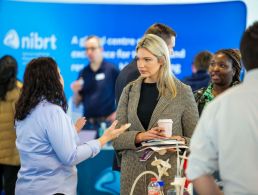The more well rounded you are, the more you can thrive in the world of technology, according to Minette Norman.
Earlier this month, design software and services firm Autodesk announced its intention to build a brand new office in Dublin, creating 200 new roles in the process.
The company is best known for its 2D and 3D design suites for architecture, engineering, construction, manufacturing and media/entertainment industries. Its software has been used to design everything from the Freedom Tower at the World Trade Center to Tesla’s electric cars.
To celebrate Engineers Week, we caught up with Autodesk’s vice-president of engineering practice, Minette Norman. She told Siliconrepublic.com about her career, how she got to her current role and why an engineering background wasn’t essential.
What first stirred your interest in a career in tech?
I first started using computers and software when I worked at the French Trade Commission in New York City. During this time, I discovered that I was a quick learner and one of my strengths was explaining complex technical information in an easy-to-understand way.
At the same time, a conversation with a good friend gave me the idea of getting into the field of technical writing, which led me to my first job in the software industry.
What education and other jobs led you to the role you now have?
My education was in the liberal arts (drama and French), which is an unexpected background for someone leading engineering at a software company. But my early jobs in technical writing were the first steps towards where I am today.
I moved from being an individual contributor as a writer, to managing a staff of writers. I then moved into managing a team of engineers working on language translation (also known as ‘localisation’) technology and I subsequently took several other management roles in localisation, ultimately leading the localisation team at Autodesk.
During my tenure in that role, I made major changes in our operating model, and I focused on automation and technology to streamline the localisation process. I became known as someone who could drive change at a large company. This led me to my current role where my charter is to transform engineering at Autodesk.
What were the biggest challenges you encountered on your career path?
I thought that the biggest challenges would be developing my technical knowledge so I could lead highly technical teams. It turns out the biggest challenges I’ve encountered have been in human dynamics in teams.
I’ve learned to embrace and appreciate diversity of style, thought and background, as that diversity leads to better ideas and stronger, high-performing teams. However, it can be challenging to get people with different styles to work together. This is an area where I feel my education continues, making me a better leader.
Was there any one person who was particularly influential as your career developed?
There hasn’t been one single person who was particularly influential but, rather, a series of people who influenced me as I progressed in my career.
My first manager at Autodesk insisted that I had leadership qualities and convinced me to take a management role, even when I resisted and thought I wanted to stay an individual contributor. She was right, and I have absolutely loved being a manager and leader of teams.
My last manager was hugely influential as he put me in the role I’m in today. My three predecessors in this role had all been men and had all come from an engineering background. My manager decided that he needed something different in the role and took a chance on a non-engineer leading the engineering practice at Autodesk.
I’ve taken to heart some wise words he shared with me: “You don’t have to do the work yourself; you have to lead others in doing that work.”
What do you enjoy about your job?
I enjoy leading a team of incredibly smart, dedicated and passionate people who want to do great things together. I enjoy seeing the work we do have a positive impact on our company and the software our customers use to make anything. I love having the opportunity to work on culture change, not only on technology and processes.
What aspects of your personality do you feel make you suited to this job?
I’m an extrovert and get my energy from others, which is a good thing because I spend almost all my time at work with other people.
I believe in transparency and I’m willing to be vulnerable in the workplace, which builds trust with others. I enjoy speaking in public, which I do often, both internally and externally. And I thrive on change and challenges, which are both constants at Autodesk.
How did Autodesk support you on your career path?
Autodesk has been remarkably supportive of my career development. I’ve had the opportunity to take many management and technical training classes over the years. I’ve had internal mentors and I also had the gift of working with an executive coach.
What advice would you give to those considering a career in tech?
My advice is to get a well-rounded education, not only in STEM but also in the arts and liberal arts. The more well rounded you are, the more you can thrive in the world of technology.
You should hone your communication skills, both written and verbal, as so much of work involves communication and influencing others. Supplement your technical skills with strong social and collaboration skills.




